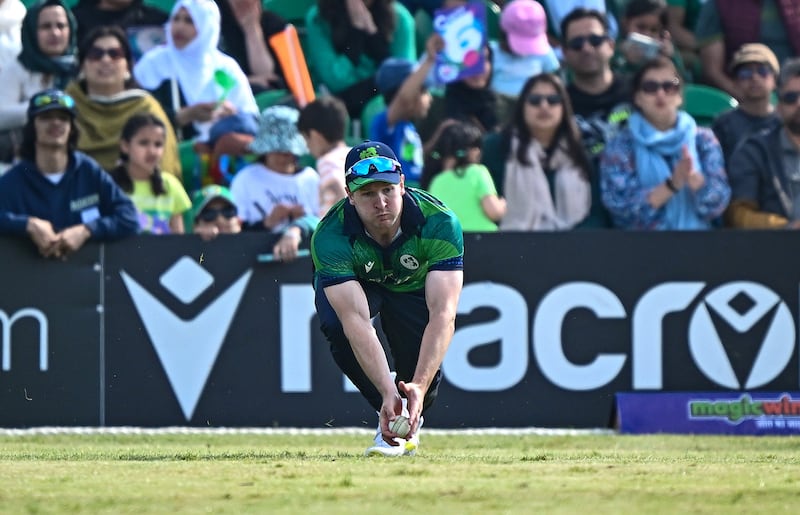1st T20 international: Pakistan 182-6 (20 ovs) (Babar Azam 57, Saim Ayub 45; Craig Young 2-27) lost to Ireland 183-5 (19.5 ovs) (Andrew Balbirnie 77, Harry Tector 36; Abbas Afridi 2-36) by 5 wickets.
After controversial company cars, protracted contract negotiations and World Cup qualifying failures dominated the headlines in recent weeks, Irish cricket needed a good news story. Andrew Balbirnie and his team-mates duly obliged, batting Ireland to a momentous five-wicket victory over Pakistan at Castle Avenue in Clontarf to kick off the home summer in style.
Balbirnie top scored with 77, his second highest T20I score, but contributions from Harry Tector (36), George Dockrell (24), Gareth Delany (10 not out) and even an audacious Curtis Campher cameo of 15 not out were all required in a tense but thoroughly entertaining end game as Ireland chased a total of 183 in the final over.
Earlier in the day, after being asked to bat by Ireland at the toss, Babar Azam (57) top-scored for Pakistan who, after a sluggish start, powered their way to a total which looked to be above par on a two-paced pitch.
RM Block
Ireland’s decision to bowl first at the toss was somewhat justified when Mark Adair found movement with the new ball. Yet for all the skills on display, it was a moment of brilliance in the field which did for Mohammad Rizwan. A mix-up with his opening partner Saim Ayub allowed Tector to run Rizwan out with a sharp throw to open Ireland’s account.

It wasn’t the last moment in the field to boost an Irish side who, given a difficult final five overs which saw Pakistan plunder 66 runs, needed all the assistance that was on offer. Barry McCarthy went wicketless with the ball, but when he wasn’t bowling the Pembroke man came inches from one spectacular diving catch before later saving a maximum on the boundary with another athletic effort. He finally did hold on to another difficult chance when diving forward to catch Fakhar Zaman. Just for good measure, he showed his footballing skills when kicking the ball on to the stumps to run out Shadab Khan.
Chasing 183, Ireland found themselves two down early on as Paul Stirling and Lorcan Tucker fell in the powerplay. That brought Tector and Balbirnie together. The former continued his T20 resurgence as he started his innings with a strong flick through the leg side. A disdainful pull on the front foot followed as Balbirnie made hay when sweeping Pakistan’s spinners.
After Tector top-edged Imad Wasim into the deep, Dockrell joined Balbirnie in the middle, promoted above Campher despite a previous weakness when starting against spin. It didn’t show, Dockrell swatting Shadab’s leg-spin down the ground before Iftikhar Ahmed gave both him and Ireland a life by stepping on the boundary when taking a potential catch.
Needing 19 off the final 12 balls with plenty of wickets in hand, Ireland’s win predictor sat at 85 per cent. That confidence didn’t account for Shaheen Afridi. His full toss castled Balbirnie for 77, the Ireland opener crestfallen having left his team-mates with plenty of work to do.
Campher came in next ahead of regular finisher Adair. He responded with a stunning, audacious reverse ramp over the wicketkeeper, a staggering shot to reach boundary with the game on the line. An upper cut brought another boundary before a flick off the pads levelled the scores. On the penultimate delivery, Ireland scampered through for the one run required, knocking off the 11 required off the final six deliveries to secure a maiden T20I victory over Pakistan.
- Sign up for push alerts and have the best news, analysis and comment delivered directly to your phone
- Find The Irish Times on WhatsApp and stay up to date
- Listen to our Inside Politics podcast for the best political chat and analysis





















